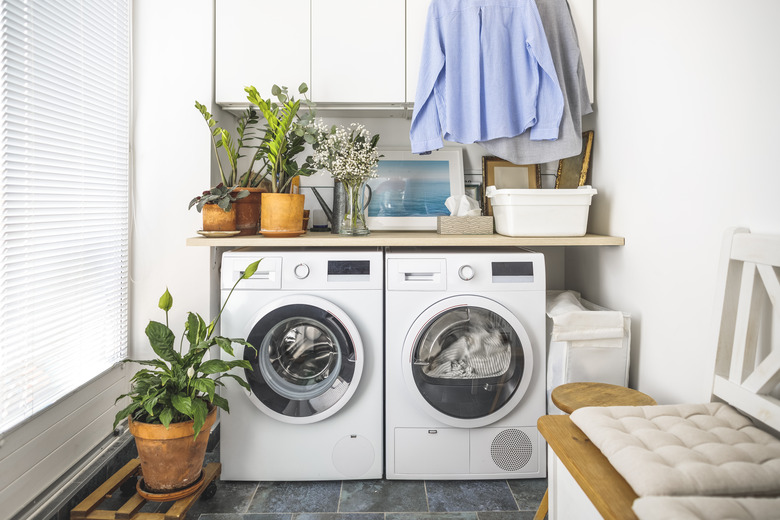How To Kill Fleas In A Dryer
We may receive a commission on purchases made from links.
If it's hot enough, a clothes dryer can absolutely kill fleas. Flea problems aren't quite so simple to solve, however. Washing and drying your pet's bedding and any clothes that may have come in contact with fleas is a smart thing to do, but laundry alone won't solve a flea issue. There are several other measures you must take while you're waiting for the dryer to work its magic.
A Comprehensive Approach
A Comprehensive Approach
Getting rid of fleas indoors requires a multifaceted approach. It involves getting the fleas off your pet, washing any clothes and bedding your pet has access to, and treating carpets and furniture. It's important to realize that it takes time to get rid of fleas in every part of their life cycle. This means repeating treatment measures at least once a week until you stop seeing any more fleas. The process can easily take four to six weeks.
While you're treating and waiting, a good way to monitor your flea problem is with flea traps. These lighted traps will never solve a flea problem, but they can serve as a good indicator of how many fleas are still in your home. You can make your own flea trap by placing a lamp containing an incandescent bulb near areas where your pet hangs out. Remove the lampshade first.
Fleas will jump onto the warmest object they can find, and a naked light bulb does the trick nicely. If you see fleas around the lamp, your flea eradication journey is not yet over.
How to Kill Fleas in a Dryer
1. Wash Whatever You Can
To get rid of fleas, you'll need to wash your pet's bedding as well as other items they have come into contact with. The combination of hot water, soap, and wringing action in the washing machine will kill most of the fleas, their larva, and their eggs. Any insects that somehow survive the washer will die from the heat and moisture removal process in the dryer.
- Launder any items you can. It's best to use hot water with temperatures around 140 degrees Fahrenheit. If your items are a bit more delicate, you may be able to get away with warm water rather than hot, but hot is always best if you can do it.
- Transfer your laundry from the washer to the dryer and run a dryer cycle. Again, high heat is best if you can use it without shrinking everything.
2. Vacuum Everything
While you're killing fleas in the dryer, your next step is to vacuum everything. And that means everything. Flea eggs hide in carpet, furniture, mattresses, grooves in laminate flooring, and in between wood floor planks. Vacuuming sucks these eggs up so you can dispose of them.
- Vacuum your home thoroughly, including carpets, furniture, mattresses, and other places your pet frequents.
- Remove the vacuum cleaner bag from your vacuum. Seal it within a plastic bag and dispose of it in an outdoor trash can.
3. Treat Your Pet
If you don't get the fleas off your pet, they will just reinfect her bedding once you take it out of the dryer. You can wash your pet with a flea shampoo or take them to the vet for an oral treatment that will kill any fleas on them.
- Read the label on your flea shampoo carefully. Some flea treatments are too strong for small animals, kittens, and puppies. Make sure the product is safe before bathing your pet in it.
- Wash your pet thoroughly according to the flea shampoo directions. Remember to wash in between your pet's toes, at the base of their tail, and around their neck, where fleas can hide in body wrinkles.
- Dry your pet thoroughly with a clean towel.
- Treat your pet with a flea and tick preventive treatment as soon after the bath as you can. Again, read the directions on each product you're using. You may need to wait a few days after the bath to apply flea repellent to your pet.
4. Call an Exterminator
You can treat fleas yourself and hopefully that will prove successful. If you feel like you're losing the battle, however, it may be time to call for backup. Because chemical pest controls and flea bombs are quite toxic, it's best to leave their use to a professional.
- Ask family and friends to recommend a good exterminator.
- Consult with the exterminator, form a plan, and schedule your flea treatment.
- Follow any and all post-treatment instructions your exterminator gives you.
References
- American Kennel Club: How to Get Rid of Dog Fleas
- Whole Dog Journal: Getting Rid of Fleas in the House
- University of California Statewide Integrated Pest Management Program: Fleas
- Oklahoma State University Extension: Flea Control
- Texas A&M AgriLife Extension: Common Insect and Mite Pests of Humans
- Universty of Nebraska: Fleas
